As you may already know, we’ve recently begun offering Mandarin Chinese on our app and in our courses. Just like in any other language, knowing how to say Chinese numbers is a very important skill for beginners to master. In this article, we’ll cover Chinese numbers from 1 to 999, as well as their pronunciation.
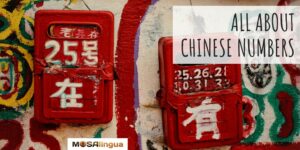
What’s inside…
Learning Numbers in Mandarin Chinese
First of all, we’re going to look at Chinese numbers from 1 to 20 in pinyin (the transcription from hanzi into the Latin alphabet). This will help you commit their pronunciation to memory.
Later, you can worry about how to write numbers in Chinese characters.
If you’d like to learn more about Chinese numbers pronunciation, download the MosaLingua app! You’ll find all the information you need to learn the language as quickly and efficiently as possible.
We’ve also compiled a page with all kinds of free resources for learning Mandarin Chinese. The sky’s the limit!
Counting from 1 to 20 in Chinese
Contrary to what you might think, Chinese numbers really aren’t that hard to learn. They actually have a pretty logical structure. So, if you can learn the Chinese numbers 0-10, (and a few other words to express tens and hundreds), you’ll know enough to build any number!
First things first, here’s how to say 0 in Chinese:
- 0 : 零 (líng)
Got it? Great! Let’s move on to the numbers from 1 to 10:
As you can see in this diagram, the numbers 1 to 9 are words that you’ll have to work to memorize. But after that, it’s a different story.
Start improving your Chinese today
Good news: we can help!
More good news: you can get started for free! With your free trial, you can test drive the most effective way to learn Mandarin Chinese for the next 15 days!
Vocabulary flashcards, videos with subtitles, audiobooks, articles adapted to your level – with MosaLingua Premium (Web & Mobile), you’ll have access to all this and more. Get started right now. It’s free—and risk-free—to try!
Did you notice a pattern?
To form other double-digit numbers, you just need to use this formula: digit + shí (+ digit).
Let’s look at a few examples:
- 30 三十 : sān (3) + shí = sān shí
- 38 三十 : sān (3) + shí + bā (8) = sān shí bā
- 40 四十 : sì (4) + shí = sì shí
- 50 五十 : wǔ (5) + shí = wǔ shí
- 69 六十九 : liù (6) + shí + jiǔ (9) = liù shí jiǔ
- 72 七十二 : qī (7) + shí + èr (2) = qī shí èr
It couldn’t be easier! (Anyone who has ever tried to learn French numbers knows the struggle that digits can be in other languages!)
🗣 How to say Chinese numbers
One important thing to keep in mind—with tonal languages like Chinese in particular—is pronunciation. Here at MosaLingua, we always say that good pronunciation is crucial to people understanding you. That’s why the MosaLingua app provides you with the pronunciation of every word you learn, recorded by a native speaker. This will give you even more opportunities to work on your accent and pronunciation.
Click the play button next to each number to hear it pronounced.
| Chinese Number Characters | Pronunciation | Pinyin Transcription | Chinese Number Characters | Pronunciation | Pinyin Transcription |
|---|---|---|---|---|---|
| 1 : 一 | yī | 11 : 十一 | shí yī | ||
| 2 : 二 | èr | 12 : 十二 | shí èr | ||
| 3 : 三 | sān | 13 : 十三 | shí sān | ||
| 4 : 四 | sì | 14 : 十四 | shí sì | ||
| 5 : 五 | wǔ | 15 : 十五 | shí wǔ | ||
| 6 : 六 | liù | 16 : 十六 | shí liù | ||
| 7 : 七 | qī | 17 : 十七 | shí qī | ||
| 8 : 八 | bā | 18 : 十八 | shí bā | ||
| 9 : 九 | jiǔ | 19 : 十九 | shí jiǔ | ||
| 10 : 十 | shí | 20 : 二十 | èr shí |
Now you know how to count to 20 in Chinese! Well done!
Counting from 21 to 99 in Chinese
Now, following the same structure, I’ll show you how to count from 21 to 99.
See? It’s really not that tricky!
The same rule that applies to two-digit numbers also applies to three-digit numbers. Let’s have a look!
Counting from 100 to 999 in Chinese
Just like we use the word shí to form two-digit numbers, we’ll have to use the word bǎi to form three-digit numbers.
As you can see in the diagram, we’re following exactly the same structure as before: digit + bǎi + digit. Now that you already know how to count from 1 to 99 in Chinese, this part will be much easier. Let’s have a closer look at a few examples:
- 115 一百一十五 : yī (1) + bǎi + yī (1) + shí + wǔ (5) = yī bǎi yī shí wǔ
- 465 四百六十五 : sì (4) + bǎi + liù (6) + shí + wǔ (5) = sì bǎi liù shí wǔ
It’s all about putting the groups together in the right order. Easy, right? Or at least easier than you’d thought, maybe? 🙂
Don’t forget that the best way to practice a foreign language, numbers included, is to talk with native speakers. If you’re looking for a native Chinese speaker to practice with, have a look at Tandem or LanguaTalk, both of which are safe and effective sites for language exchanges and tutoring!
*Our team has tested the services mentioned in this article. We recommend them wholeheartedly because we like them and we think they are useful. For the sake of full transparency, we may receive a small commission if you click the link and make a purchase. Don’t worry, there is no extra cost to you.
We also have a guide about how to meet Chinese conversation partners, both in China and in your home country! It gives some tips about where to find potential partners, plus how to make the most of your time together.
Lucky and Unlucky Numbers in Chinese Culture
An article on Chinese numbers wouldn’t quite be complete without a brief mention of the superstitions surrounding Chinese numbers. It’s important for any beginner with an interest in Chinese culture to note that numbers carry a lot of symbolism.
Lucky numbers in Chinese culture
The number 8 is considered the luckiest number because it symbolizes wealth. It’s not uncommon for people to schedule important events like weddings or grand openings on the 8th of the month. Many other numbers carry positive symbolism, like 9 (jiu) which is a similar word to the Chinese “everlasting.” The number 2 is also considered positive because Chinese tradition believes that all good things come in pairs.

Unlucky Chinese numbers
On the other hand, it’s perhaps even more important to note that the number 4 is considered the most unlucky number of all. The word for “four” (sì) is similar to the word for “death.” It’s considered very bad form to gift an amount of money or any object that incorporates the number 4. In fact, some buildings in China skip over the fourth floor entirely!
Bonus Skill: Chinese Phone Numbers
And believe it or not, now that you know how to count from 0 to 9, you have all the tools you need to say a phone number in Chinese. All you need to do is pronounce each digit individually.
💡 MosaTip: There’s one small exception. Because the numbers 1 (yī) and 7 (qī) rhyme, it’s common practice to pronounce the number “1” as “yāo” to avoid confusion. You’ll sound like a true native speaker if you do that!
For example, a phone number of 123-4678-9012 is said as yāo-èr-sān-sì-wǔ-liù-qī-bā-jiǔ-líng-yāo-èr.
Chinese phone number format
You might have noticed that there are a couple more digits than you’re used to. In mainland China, mobile phone numbers have 11 digits in the format 1xx-xxxx-xxxx. The first three digits designate the mobile phone service provider.
Next Steps
If you enjoyed this article and would like to read more about Chinese-language resources, check out these other titles:
- How to Speak Chinese: Tools & techniques to learn Mandarin
- Chinese Movies for Mandarin Learners, including the best Chinese movies on Netflix
- How to Say Hello in Chinese 👋: 12 Chinese greetings
You can also learn how to count in other languages:
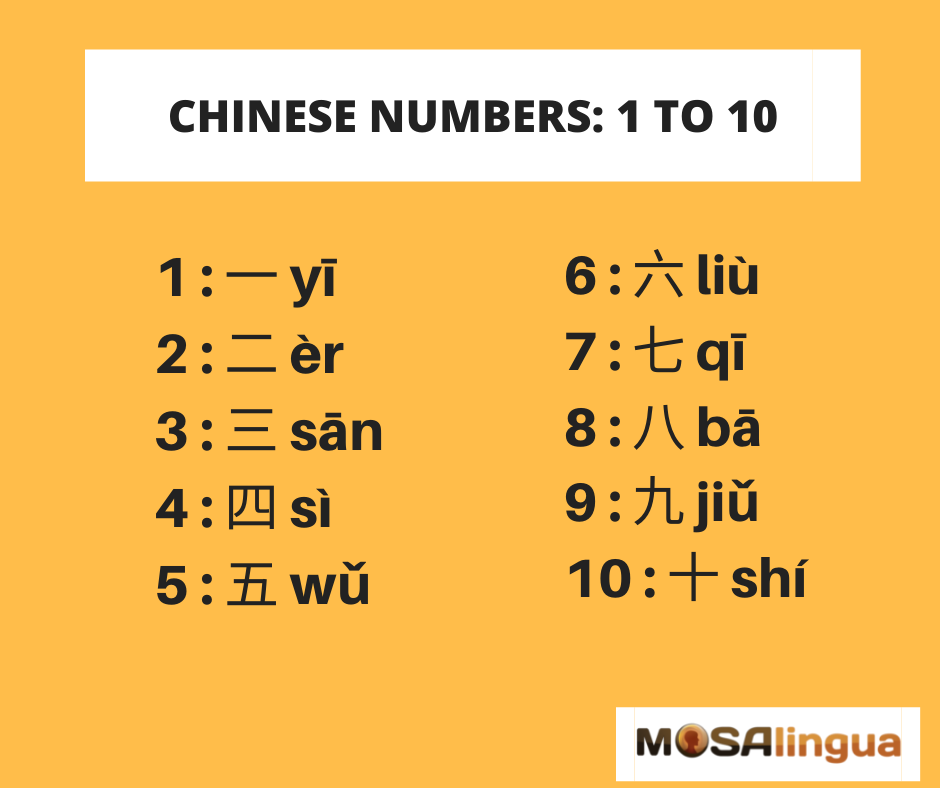

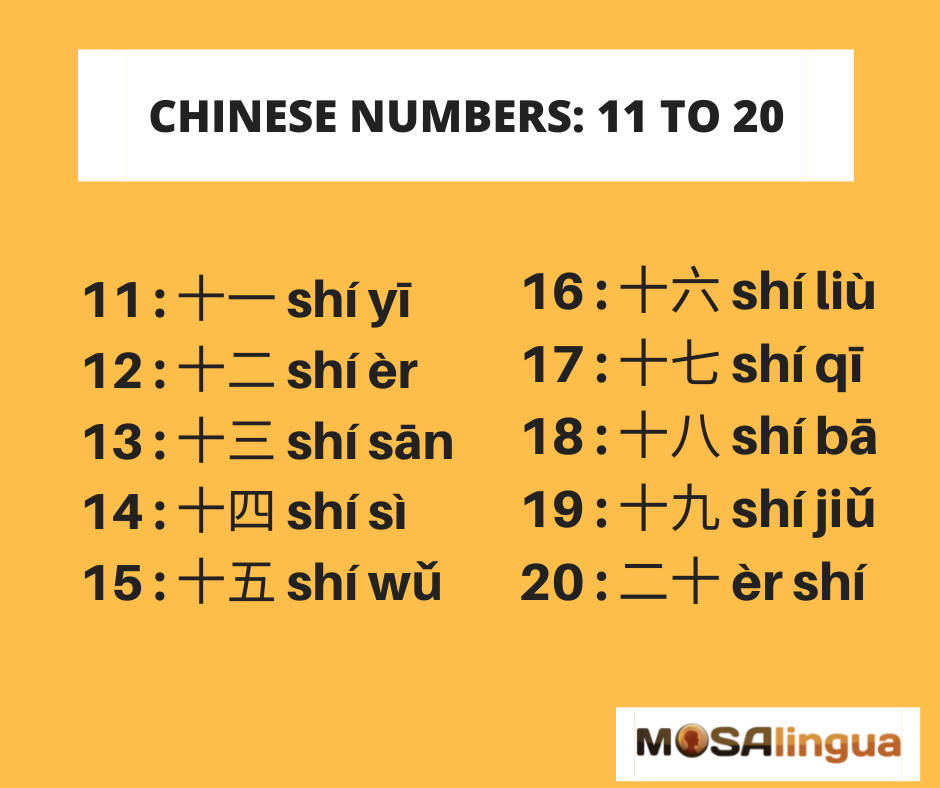
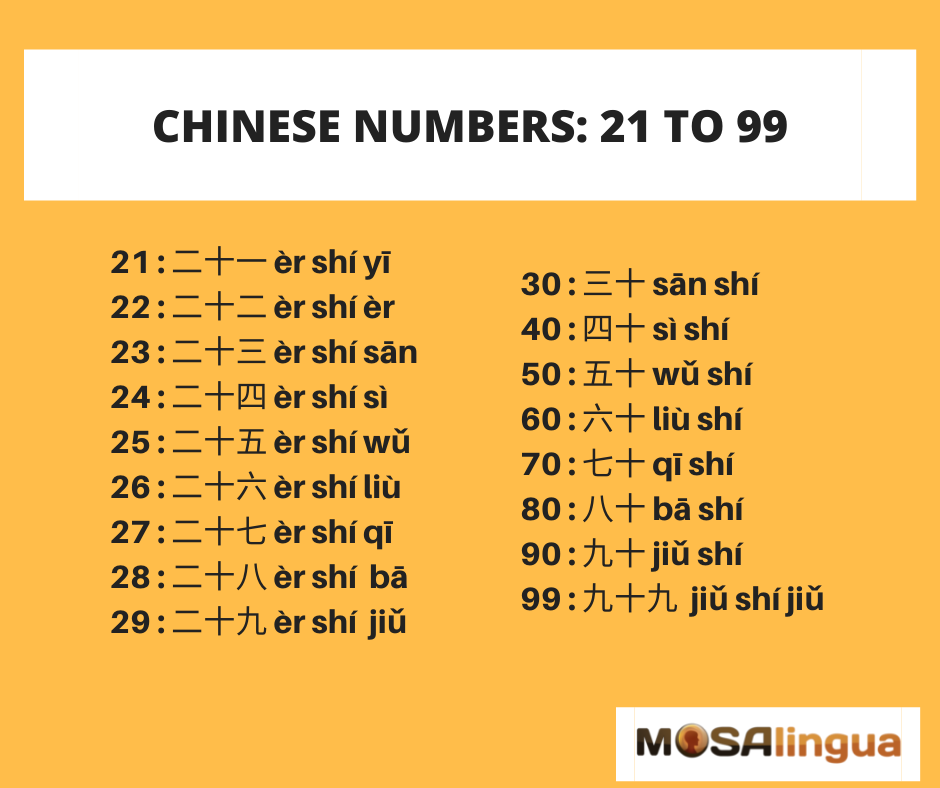
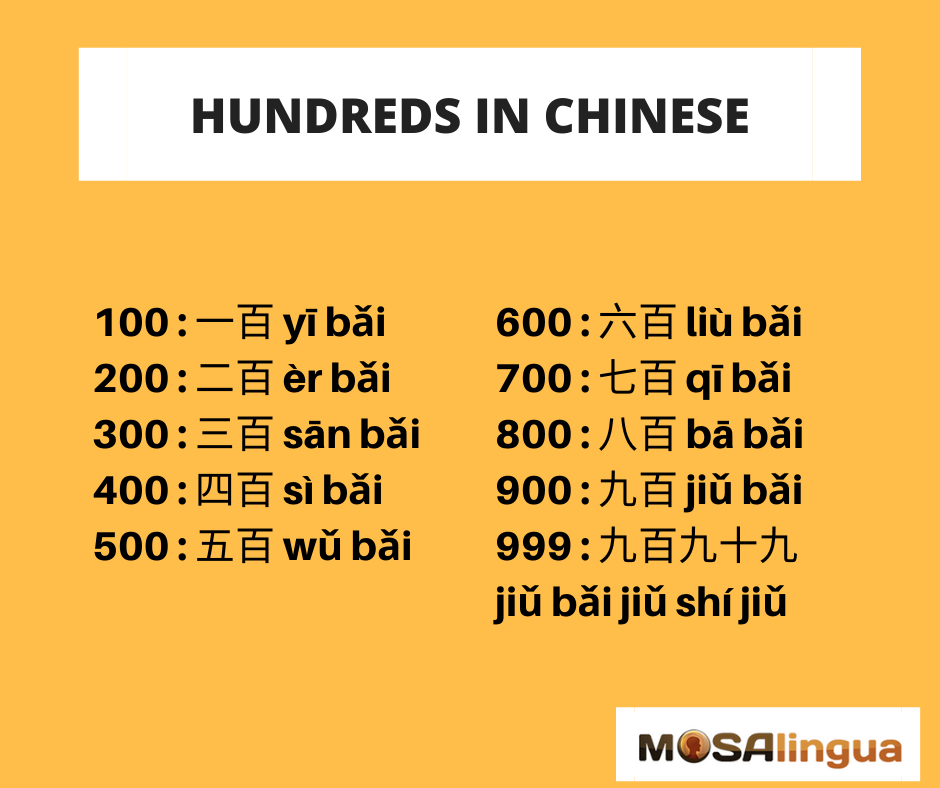




Comments